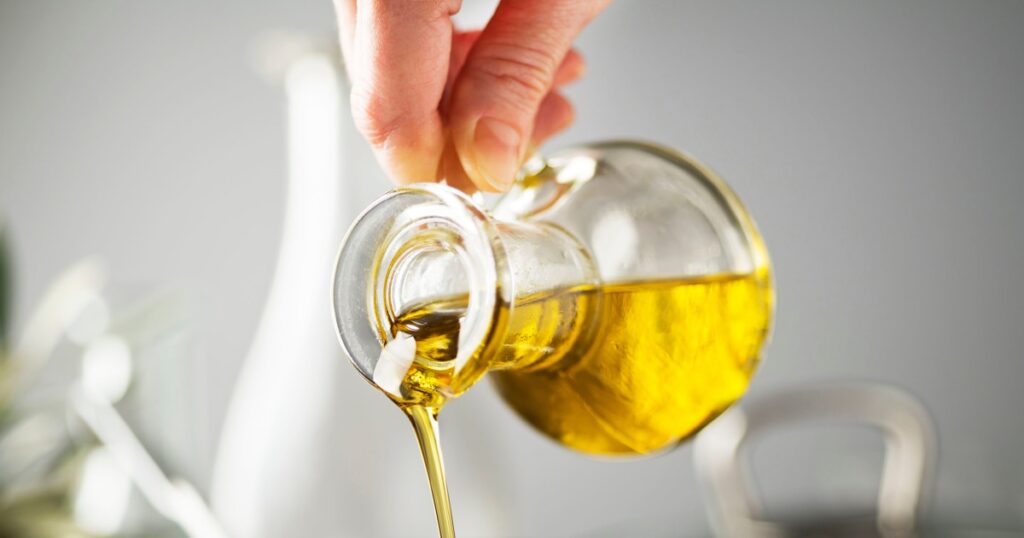Cooking oil is a kitchen staple. It can help prevent sticking, sear meat or vegetables to perfection, moisten a cake, dress a salad and so much more.
At the grocery store, you’ll find an endless array of oils from plants, seeds and other sources. It may leave you wondering: which type of cooking oil is the healthiest? Does it matter if it comes in a big plastic jug or a fancy glass bottle?
Where the oil comes from and how it’s processed can impact its nutrition content and flavor. In short, not all oil is equal. We spoke to dietitians about what to look for when choosing a cooking oil, which oils are healthiest and which oils to limit or avoid.
Is cooking with oil healthy?
“Cooking oil can definitely be part of a healthy diet,” says Natalie Rizzo, registered dietitian and nutrition editor for TODAY.com. Oils can provide essential fatty acids and other nutrients that promote overall health — not to mention, they make food taste a lot better.
Oils are basically pure fat, but fats are an important macronutrient that plays many roles in the body, from providing us with energy to supporting cell function, TODAY.com previously reported.
The key is to consume fewer “bad” fats (trans and saturated) and replace these with more “good” or healthy fats (polyunsaturated and monounsaturated), per the American Heart Association.
It’s important to note that consuming any kind of fat will add additional calories to your intake, Beth Czerwony, registered dietitian with the Cleveland Clinic’s Center for Human Nutrition, tells TODAY.com. “That needs to be considered when evaluating your diet overall,” Czerwony adds.
Moderation is also key. “The serving size for oil is small — one tablespoon — and having more than that can drastically increase your calorie and fat intake above the recommended amount,” says Rizzo. All fat provides 9 calories per gram.
The World Health Organization recommends all adults limit their total fat intake to 30% of their caloric intake or less. If you’re unsure about how many grams of fat you should be eating per day to meet your needs and goals, talk to a nutritionist or your healthcare provider.
Choosing healthier oils
When choosing a cooking oil, it’s important to read the nutrition labels and consider several factors.
Saturated fat
“Some cooking oils may have negative health effects if used in excess, these include those high in saturated fats,” says Czerwony. Saturated fat can raise bad cholesterol or LDL, which can clog the arteries, and consuming high amounts over time increases the risk of heart disease and stroke, per the AHA.
“The American Heart Association recommends choosing oils with less than four grams of saturated fats per one tablespoon (or serving),” says Czerwony.
Fortunately, many cooking oils also contain unsaturated fats, Rizzo adds. Oils rich in monounsaturated and polyunsaturated fats provide the body with essential nutrients, including vitamins and antioxidants.
Healthy fats can boost HDL, or good cholesterol, lower LDL, and stabilize blood glucose levels, TODAY.com previously reported. Unsaturated fats are also beneficial for heart and brain health, says Rizzo.
Oils high in unsaturated fats are liquid at room temperature, whereas those high in saturated fats are solid. “A good way to know if it’s saturated fat is to remember, solid at room temperature equals solid in your arteries,” says Czerwony.
Nontropical plant source
Where the oil comes from can also affect its nutrition content. “There’s oils from fruits, such as olive oil and avocado oil. There are also oils that come from seeds, like canola oil, sunflower seed oil and grapeseed oil. Lastly, there are nut oils, like walnut or peanut oil,” says Rizzo.
The experts recommend opting for cooking oils from nontropical fruits, vegetables, nuts or seeds, as these are healthier choices.
Oils from tropical plants — primarily coconut, palm and palm kernel oil — are much higher in saturated fat and remain solid at room temperature, says Czerwony.
Other types of solid fats used in cooking include animal fats — such as butter, lard, or tallow — which contain large amounts of saturated fat and have been shown to raise bad cholesterol, per the AHA.
Trans fats are formed through a process which uses hydrogen to turn liquid vegetable oil into a solid fat, such as margarine and shortening, per the National Institutes of Health. These should be avoided due to the health risks.
Refined vs. unrefined
When choosing a cooking oil, it’s important to consider how it was processed. Many plant oils are refined to remove particles and make them more heat- and shelf-stable, Czerwony notes.
Refined oils are often cheaper and last longer. They may have a very neutral flavor and withstand higher cooking temperatures, which makes them a practical option in the kitchen.
However, the refining process also removes a number of benefits from the oil, the experts note. “Look for unrefined oils if possible, which will still have more nutrients and antioxidants that are often lost in the refining process,” says Czerwony.
Unrefined oils may appear cloudier or contain sediment, but have a more robust or complex flavor. They tend to be more expensive and have a shorter shelf life, says Czerwony, but the added health and gastronomic benefits are worth it.
Bottom line: When choosing between cooking oils at the grocery store, the experts recommend picking oils that are:
- Low in saturated fat (fewer than four grams per tablespoon)
- Nontropical
- Unrefined
Which oil is best for heating?
Another factor to consider is the cooking method and the “smoke point” of the oil, says Czerwony.
All oils have a smoke point, or a temperature at which the oil starts to degrade and burn, per the U.S. Department of Agriculture. It usually ranges from 325 degrees to 450 degrees Fahrenheit.
“Heating oil breaks down the composition of the oil, which can change the flavor and nutrition,” says Rizzo. Oil can oxidize when it’s exposed to too much heat (or light). “The antioxidants and fat levels in the oil determine how quickly it will oxidize,” Rizzo adds.
Heating oil beyond its smoke point can destroy nutrients and produce free radicals, which damage cells, Czerwony explains. It also causes the oil to taste rancid, which can ruin a dish.
Certain oils are better to use when cooking with high heat — such as searing or frying. These can withstand high temperatures without burning, which should be avoided, says Czerwony. Oils with a high smoke point include avocado, canola, peanut and soybean oils.
Other oils are more suited to medium heat cooking methods, such as baking or sautéing, including olive, grapeseed and vegetable oils.
Oils with a low smoke point should not be heated. “These are (best) for salad dressings or as a flavor enhancement to finish a dish,” says Czerwony. These include walnut, flaxseed and wheat germ oils.
Always make sure to read the label, which often indicates which purposes or cooking methods are best.
What is the healthiest cooking oil?
Olive oil
Olive oil is the top pick among the experts due to its variety of well-researched health benefits. It’s also versatile and can be used to cook or enhance many hot and cold dishes.
Olive oil is packed with healthy fats, including monounsaturated fatty acids — it has the highest amount of any plant oil, per the AHA — which can help lower LDL and blood pressure.
It’s also rich in plant-compounds called polyphenols, vitamins and antioxidants, which have been shown to decrease inflammation and improve heart health, says Czerwony. “Including olive oil in the diet has been linked to reductions in heart disease, diabetes and other chronic diseases,” Rizzo adds.
The experts recommend opting for “extra virgin olive oil” or EVOO, as this is the least processed and typically cold-pressed which retains more nutrients and flavor.
It withstand temperatures up to 410 degrees Fahrenheit, per the USDA, which makes it a great option to bake, sauté, roast and more. Extra virgin olive oil also has the lowest oxidation rate of any oil, per the Cleveland Clinic, which means it’s more stable and less prone to emitting free radicals when heating.
One tablespoon or serving of olive oil contains about 119 calories and 13.5 grams of fat, according to the USDA.
Other healthy cooking oils
There are a number of other nontropical plant oils which provide good fats, vitamins and antioxidants, making them a healthy choice in the kitchen. When choosing an oil, it’s important to consider the flavor and smoke point, as well as any food allergies.
- Avocado
- Canola
- Corn
- Peanut
- Safflower
- Soybean
- Grapeseed
- Sunflower
“Vegetable oil” is typically made from one or a blend of these oils.
What is the least healthy cooking oil?
The least healthy cooking oil is coconut oil, the experts note. “Basically every single oil, except for coconut oil, is a good source of unsaturated fats and is a healthy option for cooking,” says Rizzo.
Coconut oil is 80-90% saturated fat, says Rizzo, compared to other oils which are typically 10–20% saturated fat. “The AHA discourages using coconut oil since the saturated fat can raise LDL cholesterol,” says Rizzo.
“Coconut oil has not had any large-scale research to support any health benefits and it far exceeds four grams saturated fats per tablespoon, making it higher in fat than butter,” says Czerwony.
If you can’t avoid coconut oil, only use it in very small amounts for cooking, says Rizzo. Palm oils are also high in saturated fats and should be avoided, says Czerwony.
Tips for using storing and cooking with oil
Common habits and mistakes in the kitchen can compromise an oil’s freshness, nutrition, and taste. It’s important to store and use cooking oil properly, says Czerwony.
- Choose oil in dark, opaque bottles which protect it from light
- Store oil in a dark, cool place to avoid oxidation or overheating
- Use cooking oil within several months of opening
- Do not use expired cooking oil
- Discard oil that smells rancid
- Do not use oil after it smokes or catches fire
- Do not reuse cooking oil
- Do not refrigerate cooking oils
Read the full article here











